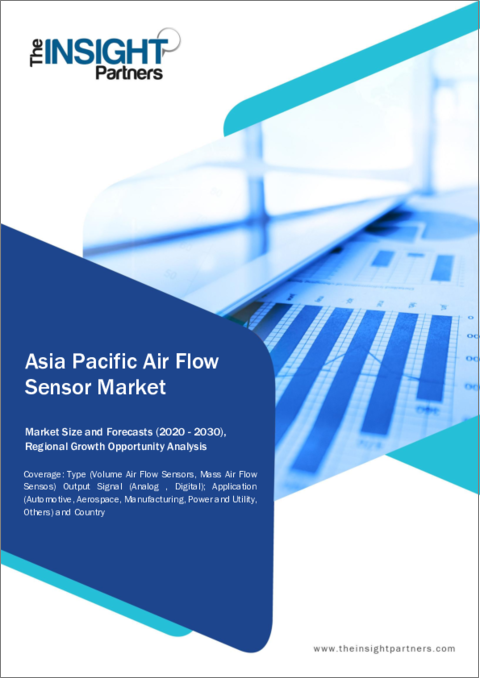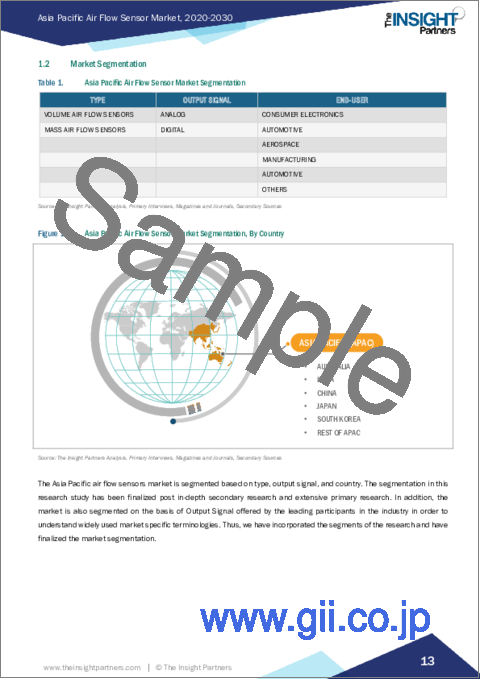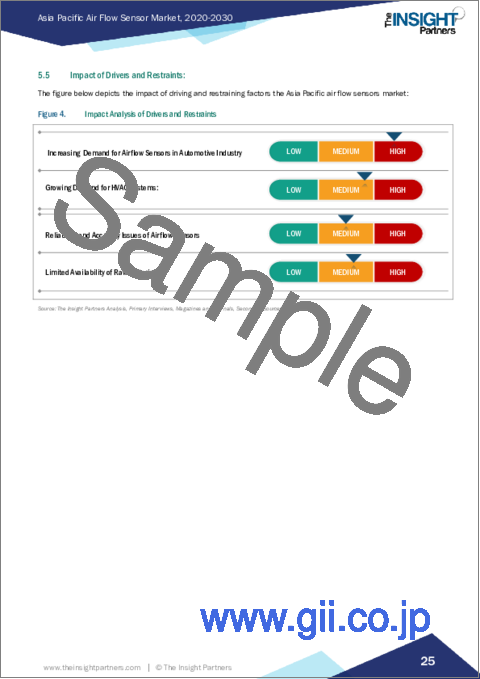|
|
市場調査レポート
商品コード
1494420
アジア太平洋のエアフローセンサー:2030年市場予測- 地域別分析- タイプ別、出力信号別、用途別Asia Pacific Air Flow Sensor Market Forecast to 2030 - Regional Analysis - by Type (Volume Air Flow Sensors and Mass Air Flow Sensos), Output Signal (Analog and Digital), and Application (Automotive, Aerospace, Manufacturing, Power & Utility, Others) |
||||||
|
|||||||
| アジア太平洋のエアフローセンサー:2030年市場予測- 地域別分析- タイプ別、出力信号別、用途別 |
|
出版日: 2024年03月14日
発行: The Insight Partners
ページ情報: 英文 88 Pages
納期: 即納可能
|
全表示
- 概要
- 図表
- 目次
アジア太平洋のエアフローセンサー市場は、2022年に9億2,474万米ドルと評価され、2030年には14億3,419万米ドルに達すると予測され、2022年から2030年までのCAGRは5.6%で成長すると予測されています。
HVACシステムの需要拡大がアジア太平洋のエアフローセンサー市場を強化
デジタルエアフローセンサーは、従来のアナログセンサに比べ、より高い精度と精度で気流を計測することができます。この精度の向上は、HVACシステム、工業プロセス、医療機器など、気流制御が重要な用途では不可欠です。これらのセンサーは風量をリアルタイムで監視し、瞬時のフィードバックと調整を可能にします。これによりプロセスやシステムの制御性が向上し、性能とエネルギー効率を最適化することができます。多くのデジタルエアフローセンサーは接続機能を持ち、遠隔監視と制御を可能にします。これは、遠隔地やアクセス困難な場所での用途や、広いエリアにわたる複数のセンサーのモニタリングに特に有益です。デジタルエアフローセンサーには、特定の用途に合わせた設定可能なものがあります。この柔軟性により、センサーの性能は様々な産業や環境の固有の要件に合致することが保証されます。デジタルセンサーは、モノのインターネット(IoT)プラットフォームやオートメーションシステムにシームレスに統合することができます。この統合により、データ駆動型の意思決定、予知保全、変化する気流状況に動的に対応するスマート環境の構築が可能になります。リアルタイムのデータとフィードバックを提供するデジタルエアフローセンサーの能力は、エネルギー効率の高い運転をサポートします。例えばHVACシステムは、実際の気流ニーズに基づいて調整され、エネルギー消費とコストを削減することができます。気流性能に関するリアルタイムのデータを提供することで、デジタルセンサーは予知保全戦略にも貢献します。これにより、予期せぬダウンタイムが減少し、機器の寿命が延びます。デジタルセンサーは、モニターする機器の健康状態や状態に関する洞察を提供することができます。気流の異常や非効率を検出することができるため、メンテナンスチームは、大きな問題に発展する前に問題を特定することができます。様々な企業がパートナーシップやコラボレーションなど、様々な取り組みを行っています。したがって、デジタルエアフローセンサーの人気の高まりは、エアフローセンサー市場の拡大をさらに後押しする可能性が高いです。
アジア太平洋のエアフローセンサー市場概要
アジア太平洋地域のエアフローセンサー市場は、オーストラリア、中国、インド、日本、韓国、その他アジア太平洋地域に細分化されます。日本、インド、中国、オーストラリア、シンガポール、台湾、インドネシアなどの国々には、エレクトロニクス、飲食品、化学、繊維、自動車、ヘルスケアなどの製造業が多数存在します。さらに、"Made in China 2025 "や"Make in India "キャンペーンといった政府の取り組みが、アジア太平洋諸国のこれらの産業を後押ししており、エアフローセンサーの需要を押し上げています。さらに、中国は航空宇宙産業が急成長しています。北京の技術に精通した候補者や若手科学者のチームは、過去に嫦娥月探査機や天文火星探査などのミッションで重要な役割を果たしてきました。航空宇宙産業におけるこうした発展が、中国のエアフローセンサー市場を牽引しています。2019年、中国科学院瀋陽自動化研究所(SIA)の中国研究者は、高い柔軟性と強力なミッション適応性を実現する空中マニピュレーターシステムの代替品を設計しました。航空宇宙産業におけるこのような市場開拓は、アジア太平洋におけるエアフローセンサー市場の成長を促進します。さらに、空気の質を監視することの重要性に対する意識の高まりは、アジア太平洋地域におけるHVACシステムの需要を強化し、それによって同地域のエアフローセンサー市場に利益をもたらしています。
アジア太平洋のエアフローセンサー市場の収益と2030年までの予測(金額)
アジア太平洋のエアフローセンサー市場のセグメンテーション
アジア太平洋のエアフローセンサー市場は、タイプ、出力信号、用途、国に区分されます。
タイプ別では、アジア太平洋のエアフローセンサー市場は、体積エアフローセンサーと質量エアフローセンサーに二分されます。2022年にはマスエアフローセンサーセグメントがより大きなシェアを占めています。
出力信号別では、アジア太平洋のエアフローセンサー市場はアナログとデジタルに二分されます。2022年にはデジタルセグメントがより大きなシェアを占めています。
用途別では、アジア太平洋のエアフローセンサー市場は自動車、航空宇宙、製造、電力・ユーティリティ、その他に分類されます。自動車セグメントが2022年に最大のシェアを占めました。
国別では、アジア太平洋のエアフローセンサー市場はオーストラリア、中国、インド、日本、韓国、その他アジア太平洋地域に区分されます。中国が2022年のアジア太平洋のエアフローセンサー市場を独占しました。
Analog Devices Inc、Degree Controls Inc、Denso Corp、Honeywell International Inc、Posifa Technologies Inc、Robert Bosch GmbH、Sensirion AG、Siemens AG、TE Connectivity Ltdは、アジア太平洋のエアフローセンサー市場で事業を展開している大手企業の一部です。
目次
第1章 イントロダクション
第2章 エグゼクティブサマリー
- 主要洞察
- 市場の魅力
第3章 調査手法
- 調査範囲
- 2次調査
- 1次調査
第4章 アジア太平洋のエアフローセンサー市場情勢
- エコシステム分析
- コンポーネントプロバイダー
- メーカー
- ディストリビューターまたはサプライヤー
- エンドユーザー産業
- バリューチェーンのベンダー一覧
第5章 アジア太平洋のエアフローセンサー市場:主要産業力学
- 促進要因
- 自動車産業におけるエアフローセンサー需要の増加
- HVACシステムの需要拡大
- 抑制要因
- 原材料の入手可能性の制限
- エアフローセンサーの信頼性と精度の問題
- 機会
- デジタルエアフローセンサーの人気の高まり
- 今後の動向
- 新技術を用いた取り組みと製品開発の増加
- 促進要因と抑制要因の影響
第6章 アジア太平洋のエアフローセンサー市場分析
- アジア太平洋のエアフローセンサー市場売上高、2022年~2030年
第7章 アジア太平洋のエアフローセンサー市場分析:タイプ
- 体積式エアフローセンサー
- マスエアフローセンサー
第8章 アジア太平洋のエアフローセンサー市場分析:出力信号編
- アナログ
- デジタル
第9章 アジア太平洋のエアフローセンサー市場分析:エンドユーザー別
- 自動車
- 航空宇宙
- 製造業
- 電力・ユーティリティ
- その他
第10章 アジア太平洋のエアフローセンサー市場:国別分析
- オーストラリア
- 中国
- インド
- 日本
- 韓国
- その他
第11章 競合情勢
- 主要企業別ヒートマップ分析
第12章 業界情勢
- 市場イニシアティブ
- 製品開発
- 合併・買収
第13章 企業プロファイル
- Honeywell International Inc
- Posifa Technologies Inc
- Siemens AG
- Denso Corp
- TE Connectivity Ltd
- Sensirion AG
- Analog Devices Inc
- Degree Controls Inc
- Robert Bosch GmbH
第14章 付録
List Of Tables
- Table 1. Asia Pacific Air Flow Sensor Market Segmentation
- Table 2. Asia Pacific Air Flow Sensor Market Revenue and Forecasts To 2030 (US$ Million) - Type
- Table 3. Asia Pacific Air Flow Sensor Market Revenue and Forecasts To 2030 (US$ Million) - Output Signal
- Table 4. Asia Pacific Air Flow Sensor Market Revenue and Forecasts To 2030 (US$ Million) - End-user
- Table 5. Asia Pacific Air Flow Sensor Market, by Country - Revenue and Forecast to 2030 (USD Million)
- Table 6. Australia: Asia Pacific Air Flow Sensor Market Revenue And Forecasts To 2030 (US$ Million) - Type
- Table 7. Australia: Asia Pacific Air Flow Sensor Market Revenue And Forecasts To 2030 (US$ Million) - Output Signal
- Table 8. Australia: Asia Pacific Air Flow Sensor Market Revenue And Forecasts To 2030 (US$ Million) - End-User
- Table 9. China: Asia Pacific Air Flow Sensor Market Revenue And Forecasts To 2030 (US$ Million) - Type
- Table 10. China: Asia Pacific Air Flow Sensor Market Revenue And Forecasts To 2030 (US$ Million) - Output Signal
- Table 11. China: Asia Pacific Air Flow Sensor Market Revenue And Forecasts To 2030 (US$ Million) - End-User
- Table 12. India: Asia Pacific Air Flow Sensor Market Revenue And Forecasts To 2030 (US$ Million) - Type
- Table 13. India: Asia Pacific Air Flow Sensor Market Revenue And Forecasts To 2030 (US$ Million) - Output Signal
- Table 14. India: Asia Pacific Air Flow Sensor Market Revenue And Forecasts To 2030 (US$ Million) - End-User
- Table 15. Japan: Asia Pacific Air Flow Sensor Market Revenue And Forecasts To 2030 (US$ Million) - Type
- Table 16. Japan: Asia Pacific Air Flow Sensor Market Revenue And Forecasts To 2030 (US$ Million) - Output Signal
- Table 17. Japan: Asia Pacific Air Flow Sensor Market Revenue And Forecasts To 2030 (US$ Million) - End-User
- Table 18. South Korea: Asia Pacific Air Flow Sensor Market Revenue And Forecasts To 2030 (US$ Million) - Type
- Table 19. South Korea: Asia Pacific Air Flow Sensor Market Revenue And Forecasts To 2030 (US$ Million) - Output Signal
- Table 20. South Korea: Asia Pacific Air Flow Sensor Market Revenue And Forecasts To 2030 (US$ Million) - End-User
- Table 21. Rest of Asia Pacific Air Flow Sensor Market Revenue And Forecasts To 2030 (US$ Million) - Type
- Table 22. Rest of Asia Pacific Air Flow Sensor Market Revenue And Forecasts To 2030 (US$ Million) - Output Signal
- Table 23. Rest of Asia Pacific Air Flow Sensor Market Revenue And Forecasts To 2030 (US$ Million) - End-User
- Table 24. Company Positioning & Concentration
- Table 25. List of Abbreviation
List Of Figures
- Figure 1. Asia Pacific Air Flow Sensor Market Segmentation, By Country
- Figure 2. Ecosystem: Asia Pacific Air Flow Sensor Market
- Figure 3. Asia Pacific Air Flow Sensor Market - Key Industry Dynamics
- Figure 4. Impact Analysis of Drivers and Restraints
- Figure 5. Asia Pacific Air Flow Sensor Market Revenue (US$ Million), 2022 - 2030
- Figure 6. Asia Pacific Air Flow Sensor Market Share (%) - Type, 2022 and 2030
- Figure 7. Asia Pacific Air Flow Sensor Market Share (%) - Output Signal, 2022 and 2030
- Figure 8. Asia Pacific Air Flow Sensor Market Share (%) - End-User, 2022 and 2030
- Figure 9. Asia Pacific Air Flow Sensor Market, by Key Country- Revenue (2022) (US$ Million)
- Figure 10. Asia Pacific Air Flow Sensor Market Breakdown By Key Countries, 2022 And 2030 (%)
- Figure 11. Australia: Asia Pacific Air Flow Sensor Market Revenue And Forecasts To 2030 (US$ Million)
- Figure 12. China: Asia Pacific Air Flow Sensor Market Revenue And Forecasts To 2030 (US$ Million)
- Figure 13. India: Asia Pacific Air Flow Sensor Market Revenue And Forecasts To 2030 (US$ Million)
- Figure 14. Japan: Asia Pacific Air Flow Sensor Market Revenue And Forecasts To 2030 (US$ Million)
- Figure 15. South Korea: Asia Pacific Air Flow Sensor Market Revenue And Forecasts To 2030 (US$ Million)
- Figure 16. Rest of Asia Pacific Air Flow Sensor Market Revenue And Forecasts To 2030 (US$ Million)
The Asia Pacific air flow sensor market was valued at US$ 924.74 million in 2022 and is expected to reach US$ 1,434.19 million by 2030; it is estimated to grow at a CAGR of 5.6% from 2022 to 2030.
Growing Demand for HVAC Systems Bolsters the Asia Pacific Air Flow Sensor Market
Digital airflow sensors offer higher accuracy and precision in measuring airflow compared to traditional analog sensors. This increased accuracy is essential in applications with critical airflow control, such as HVAC systems, industrial processes, and medical devices. These sensors provide real-time monitoring of airflow rates, allowing for instant feedback and adjustments. It enables better control over processes and systems, optimizing performance and energy efficiency. Many digital airflow sensors have connectivity features, enabling remote monitoring and control. This is particularly beneficial for applications in remote or difficult-to-access locations and for monitoring multiple sensors across a large area. Digital airflow sensors come with configurable settings tailored to specific applications. This flexibility ensures that the sensor's performance aligns with the unique requirements of different industries and environments. Digital sensors can seamlessly integrate into the Internet of Things (IoT) platforms and automation systems. This integration allows for data-driven decision-making, predictive maintenance, and the creation of smart environments that respond dynamically to changing airflow conditions. The ability of digital airflow sensors to provide real-time data and feedback supports energy-efficient operations. HVAC systems, for instance, can be adjusted based on actual airflow needs, reducing energy consumption and costs. By providing real-time data on airflow performance, digital sensors contribute to predictive maintenance strategies. This reduces unexpected downtime and extends the lifespan of the equipment. Digital sensors can provide insights into the health and condition of the equipment they monitor. They can detect abnormalities or inefficiencies in airflow, helping maintenance teams identify issues before they escalate into larger problems. Various companies are taking various initiatives, such as partnerships and collaboration. Hence, the growing popularity of digital airflow sensors is likely to further boost the airflow sensors market expansion.
Asia Pacific Air Flow Sensor Market Overview
The Asia Pacific airflow sensors market is sub segmented into Australia, China, India, Japan, South Korea, and the Rest of Asia Pacific. Countries such as Japan, India, China, Australia, Singapore, Taiwan, and Indonesia have a plethora of manufacturing industries, including electronics, food & beverage, chemicals, textiles, automobiles, and healthcare. Moreover, government initiatives such as the "Made in China 2025" and "Make in India" campaign boost these industries in different Asia Pacific countries, which propels the demand for airflow sensors. Further, China has a rapidly growing aerospace industry. A team of technologically well-versed candidates and young scientists in Beijing have played significant roles in missions such as Chang'e lunar probes and the Tianwen Mars exploration in the past. Such developments in the aerospace industry drive the air flow sensors market in China. In 2019, Chinese researchers at the Shenyang Institute of Automation (SIA) of the Chinese Academy of Sciences designed an alternative for aerial manipulator systems for high flexibility and strong mission adaptability. Such developments in the aerospace industry propel the growth of the airflow sensors market in Asia Pacific. Further, the growing awareness of the importance of monitoring air quality bolsters the demand for HVAC systems in Asia Pacific, thereby benefiting the airflow sensors market in the region.
Asia Pacific Air Flow Sensor Market Revenue and Forecast to 2030 (US$ Million)
Asia Pacific Air Flow Sensor Market Segmentation
The Asia Pacific air flow sensor market is segmented into type, output signal, application, and country.
Based on type, the Asia Pacific air flow sensor market is bifurcated into volume air flow sensors and mass air flow sensors. The mass air flow sensors segment held a larger share in 2022.
By output signal, the Asia Pacific air flow sensor market is bifurcated into analog and digital. The digital segment held a larger share in 2022.
In terms of application, the Asia Pacific air flow sensor market is categorized into automotive, aerospace, manufacturing, power & utility, others. The automotive segment held the largest share in 2022.
Based on country, the Asia Pacific air flow sensor market is segmented Australia, China, India, Japan, South Korea, and the Rest of Asia Pacific. China dominated the Asia Pacific air flow sensor market in 2022.
Analog Devices Inc, Degree Controls Inc, Denso Corp, Honeywell International Inc, Posifa Technologies Inc, Robert Bosch GmbH, Sensirion AG, Siemens AG, and TE Connectivity Ltd are some of the leading companies operating in the Asia Pacific air flow sensor market.
Table Of Contents
1. Introduction
- 1.1 The Insight Partners Research Report Guidance
- 1.2 Market Segmentation
2. Executive Summary
- 2.1 Key Insights
- 2.2 Market Attractiveness
3. Research Methodology
- 3.1 Coverage
- 3.2 Secondary Research
- 3.3 Primary Research
4. Asia Pacific Air Flow Sensor Market Landscape
- 4.1 Overview
- 4.2 Ecosystem Analysis
- 4.2.1 Component Providers:
- 4.2.2 Manufacturers:
- 4.2.3 Distributors or Suppliers:
- 4.2.4 End-Use Industries:
- 4.2.5 List of Vendors in Value Chain:
5. Asia Pacific Air Flow Sensor Market - Key Industry Dynamics
- 5.1 Drivers
- 5.1.1 Increasing Demand for Airflow Sensors in Automotive Industry
- 5.1.2 Growing Demand for HVAC Systems:
- 5.2 Restraints:
- 5.2.1 Limited Availability of Raw Materials
- 5.2.2 Reliability and Accuracy Issues of Airflow Sensors
- 5.3 Opportunity:
- 5.3.1 Growing Popularity of Digital Airflow Sensors
- 5.4 Future Trends:
- 5.4.1 Increasing Initiatives & Product Development Using New Technologies
- 5.5 Impact of Drivers and Restraints:
6. Air Flow Sensor Market - Asia Pacific Market Analysis
- 6.1 Overview
- 6.2 Asia Pacific Air Flow Sensor Market Revenue (US$ Million), 2022 - 2030
7. Asia Pacific Air Flow Sensor Market Analysis - Type
- 7.1 Volume Air Flow Sensors
- 7.1.1 Overview
- 7.1.2 Volume Air Flow Sensors Market Revenue and Forecasts To 2030 (US$ Million)
- 7.2 Mass Air Flow Sensors
- 7.2.1 Overview
- 7.2.2 Mass Air Flow Sensors Market Revenue and Forecasts To 2030 (US$ Million)
8. Asia Pacific Air Flow Sensor Market Analysis - Output Signal
- 8.1 Analog
- 8.1.1 Overview
- 8.1.2 Analog Market Revenue and Forecasts To 2030 (US$ Million)
- 8.2 Digital
- 8.2.1 Overview
- 8.2.2 Digital Market Revenue and Forecasts To 2030 (US$ Million)
9. Asia Pacific Air Flow Sensor Market Analysis - End-User
- 9.1 Automotive
- 9.1.1 Overview
- 9.1.2 Automotive Market Revenue and Forecasts To 2030 (US$ Million)
- 9.2 Aerospace
- 9.2.1 Overview
- 9.2.2 Aerospace Market Revenue and Forecasts To 2030 (US$ Million)
- 9.3 Manufacturing
- 9.3.1 Overview
- 9.3.2 Manufacturing Market Revenue and Forecasts To 2030 (US$ Million)
- 9.4 Power & Utility
- 9.4.1 Overview
- 9.4.2 Power & Utility Market Revenue and Forecasts To 2030 (US$ Million)
- 9.5 Others
- 9.5.1 Overview
- 9.5.2 Others Market Revenue and Forecasts To 2030 (US$ Million)
10. Asia Pacific Air Flow Sensor Market - Country Analysis
- 10.1 Asia Pacific Air Flow Sensor Market, by Key Country- Revenue (2022) (US$ Million)
- 10.1.1 Asia Pacific Air Flow Sensor market Breakdown by Country
- 10.1.1.1 Australia: Asia Pacific Air Flow Sensor Market Revenue and Forecasts To 2030 (US$ Million)
- 10.1.1.1.1 Australia: Asia Pacific Air Flow Sensor Market Breakdown by Type
- 10.1.1.1.2 Australia: Asia Pacific Air Flow Sensor Market Breakdown by Output Signal
- 10.1.1.1.3 Australia: Asia Pacific Air Flow Sensor Market Breakdown by End-User
- 10.1.1.2 China: Asia Pacific Air Flow Sensor Market Revenue and Forecasts To 2030 (US$ Million)
- 10.1.1.2.1 China: Asia Pacific Air Flow Sensor Market Breakdown by Type
- 10.1.1.2.2 China: Asia Pacific Air Flow Sensor Market Breakdown by Output Signal
- 10.1.1.2.3 China: Asia Pacific Air Flow Sensor Market Breakdown by End-User
- 10.1.1.3 India: Asia Pacific Air Flow Sensor Market Revenue and Forecasts To 2030 (US$ Million)
- 10.1.1.3.1 India: Asia Pacific Air Flow Sensor Market Breakdown by Type
- 10.1.1.3.2 India: Asia Pacific Air Flow Sensor Market Breakdown by Output Signal
- 10.1.1.3.3 India: Asia Pacific Air Flow Sensor Market Breakdown by End-User
- 10.1.1.4 Japan: Asia Pacific Air Flow Sensor Market Revenue and Forecasts To 2030 (US$ Million)
- 10.1.1.4.1 Japan: Asia Pacific Air Flow Sensor Market Breakdown by Type
- 10.1.1.4.2 Japan: Asia Pacific Air Flow Sensor Market Breakdown by Output Signal
- 10.1.1.4.3 Japan: Asia Pacific Air Flow Sensor Market Breakdown by End-User
- 10.1.1.5 South Korea: Asia Pacific Air Flow Sensor Market Revenue and Forecasts To 2030 (US$ Million)
- 10.1.1.5.1 South Korea: Asia Pacific Air Flow Sensor Market Breakdown by Type
- 10.1.1.5.2 South Korea: Asia Pacific Air Flow Sensor Market Breakdown by Output Signal
- 10.1.1.5.3 South Korea: Asia Pacific Air Flow Sensor Market Breakdown by End-User
- 10.1.1.6 Rest of Asia Pacific Air Flow Sensor Market Revenue and Forecasts To 2030 (US$ Million)
- 10.1.1.6.1 Rest of Asia Pacific Air Flow Sensor Market Breakdown by Type
- 10.1.1.6.2 Rest of Asia Pacific Air Flow Sensor Market Breakdown by Output Signal
- 10.1.1.6.3 Rest of Asia Pacific Air Flow Sensor Market Breakdown by End-User
- 10.1.1.1 Australia: Asia Pacific Air Flow Sensor Market Revenue and Forecasts To 2030 (US$ Million)
- 10.1.1 Asia Pacific Air Flow Sensor market Breakdown by Country
11. Competitive Landscape
- 11.1 Heat Map Analysis By Key Players
12. Industry Landscape
- 12.1 Overview
- 12.2 Market Initiative
- 12.3 Product Development
- 12.4 Mergers & Acquisitions
13. Company Profiles
- 13.1 Honeywell International Inc
- 13.1.1 Key Facts
- 13.1.2 Business Description
- 13.1.3 Products and Services
- 13.1.4 Financial Overview
- 13.1.5 SWOT Analysis
- 13.1.6 Key Developments
- 13.2 Posifa Technologies Inc
- 13.2.1 Key Facts
- 13.2.2 Business Description
- 13.2.3 Products and Services
- 13.2.4 Financial Overview
- 13.2.5 SWOT Analysis
- 13.2.6 Key Developments
- 13.3 Siemens AG
- 13.3.1 Key Facts
- 13.3.2 Business Description
- 13.3.3 Products and Services
- 13.3.4 Financial Overview
- 13.3.5 SWOT Analysis
- 13.3.6 Key Developments
- 13.4 Denso Corp
- 13.4.1 Key Facts
- 13.4.2 Business Description
- 13.4.3 Products and Services
- 13.4.4 Financial Overview
- 13.4.5 SWOT Analysis
- 13.4.6 Key Developments
- 13.5 TE Connectivity Ltd
- 13.5.1 Key Facts
- 13.5.2 Business Description
- 13.5.3 Products and Services
- 13.5.4 Financial Overview
- 13.5.5 SWOT Analysis
- 13.5.6 Key Developments
- 13.6 Sensirion AG
- 13.6.1 Key Facts
- 13.6.2 Business Description
- 13.6.3 Products and Services
- 13.6.4 Financial Overview
- 13.6.5 SWOT Analysis
- 13.6.6 Key Developments
- 13.7 Analog Devices Inc
- 13.7.1 Key Facts
- 13.7.2 Business Description
- 13.7.3 Products and Services
- 13.7.4 Financial Overview
- 13.7.5 SWOT Analysis
- 13.7.6 Key Developments
- 13.8 Degree Controls Inc
- 13.8.1 Key Facts
- 13.8.2 Business Description
- 13.8.3 Products and Services
- 13.8.4 Financial Overview
- 13.8.5 SWOT Analysis
- 13.8.6 Key Developments
- 13.9 Robert Bosch GmbH
- 13.9.1 Key Facts
- 13.9.2 Business Description
- 13.9.3 Products and Services
- 13.9.4 Financial Overview
- 13.9.5 SWOT Analysis
- 13.9.6 Key Developments
14. Appendix
- 14.1 About The Insight Partners
- 14.2 Word Index






